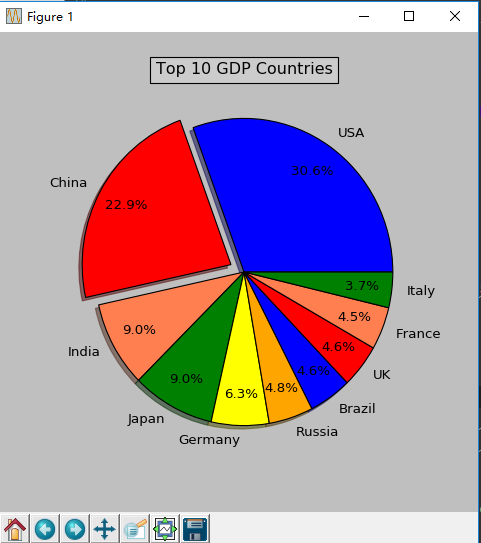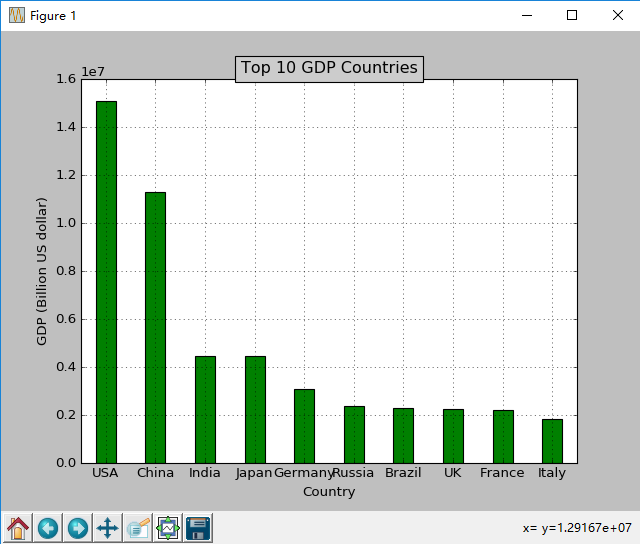每一个数据首先是列表,然后进行赋值:
# -*- coding: utf-8 -*- import numpy as np import matplotlib.pyplot as plt import matplotlib as mpl def draw_pie(labels, quants): # make a square figure plt.figure( figsize=(6, 6))#表示绘画一个图,图的大小是6*6 # # For China, make the piece explode a bit expl = [0, 0.1, 0, 0, 0, 0, 0, 0, 0, 0] # Colors used. Recycle if not enough. colors = ["blue", "red", "coral", "green", "yellow", "orange"] # Pie Plot # autopct: format of "percent" string; plt.pie(quants, explode=expl, colors=colors, labels=labels, autopct='%1.1f%%', pctdistance=0.8, shadow=True) plt.title('Top 10 GDP Countries', bbox={'facecolor': '0.8', 'pad': 5}) plt.show() def draw_bar(labels, quants): width = 0.4 ind = np.linspace(0.5, 9.5, 10)#0.5到9.5之间,划为10个数 # make a square figure fig = plt.figure(1) ax = fig.add_subplot(111)#表示画图,画的图分为几行几列,第几块 #2,绘制多个子图使用subplot(a,b,c)命令,里面有三个参数,分别代表每一行,每一列的子图的个数和当前子图的编号。 当这三个参数都小于10的时候可以省略其中的','。我们还是从一 # Bar Plot ax.bar(ind - width / 2, quants, width, color='green') # Set the ticks on x-axis ax.set_xticks(ind) ax.set_xticklabels(labels)#设置标签 # labels ax.set_xlabel('Country') ax.set_ylabel('GDP (Billion US dollar)') # title ax.set_title('Top 10 GDP Countries', bbox={'facecolor': '0.8', 'pad': 5}) plt.grid(True) plt.show() def draw_line(labels, quants): ind = np.linspace(0, 9, 10) fig = plt.figure(1) ax = fig.add_subplot(111) ax.plot(ind, quants) ax.set_title('Top 10 GDP Countries', bbox={'facecolor': '0.8', 'pad': 5}) ax.set_xticklabels(labels) plt.grid(True) plt.show() # quants: GDP # labels: country name labels = ['USA', 'China', 'India', 'Japan', 'Germany', 'Russia', 'Brazil', 'UK', 'France', 'Italy'] quants = [15094025.0, 11299967.0, 4457784.0, 4440376.0, 3099080.0, 2383402.0, 2293954.0, 2260803.0, 2217900.0, 1846950.0] draw_pie(labels, quants) draw_bar(labels,quants) draw_line(labels,quants)


